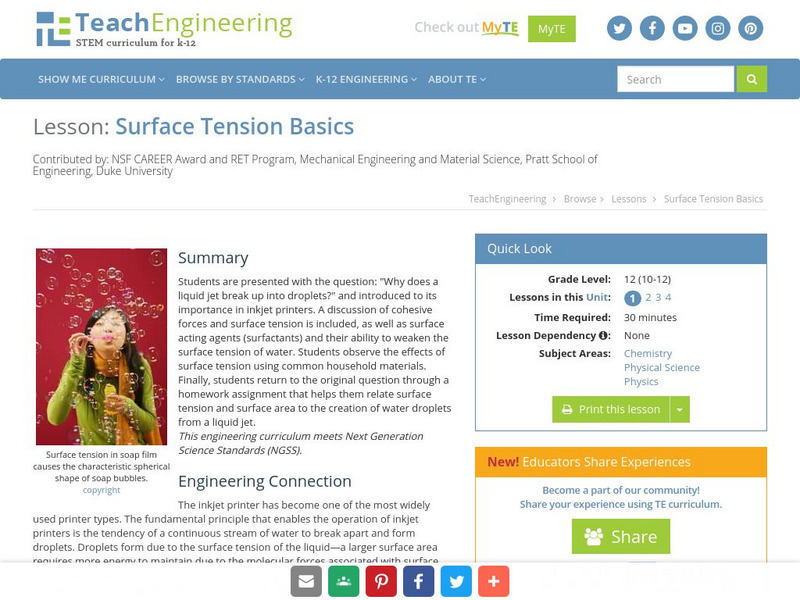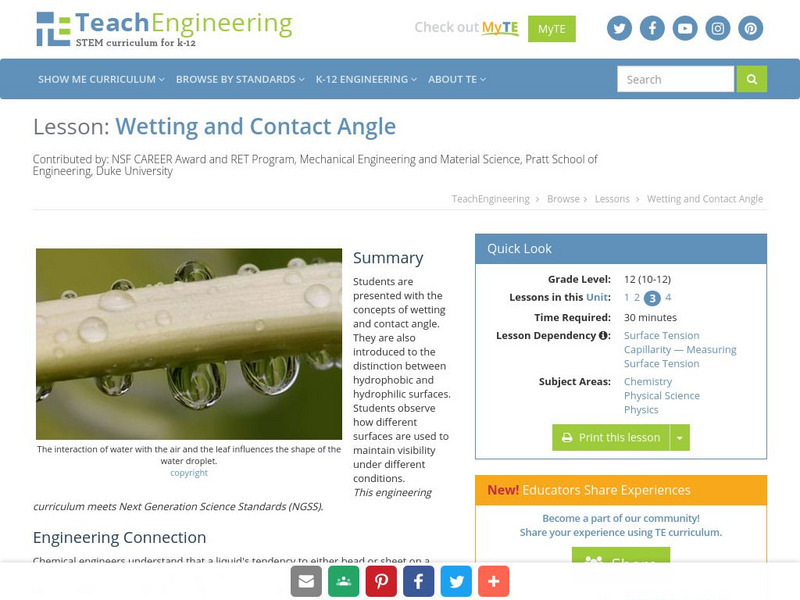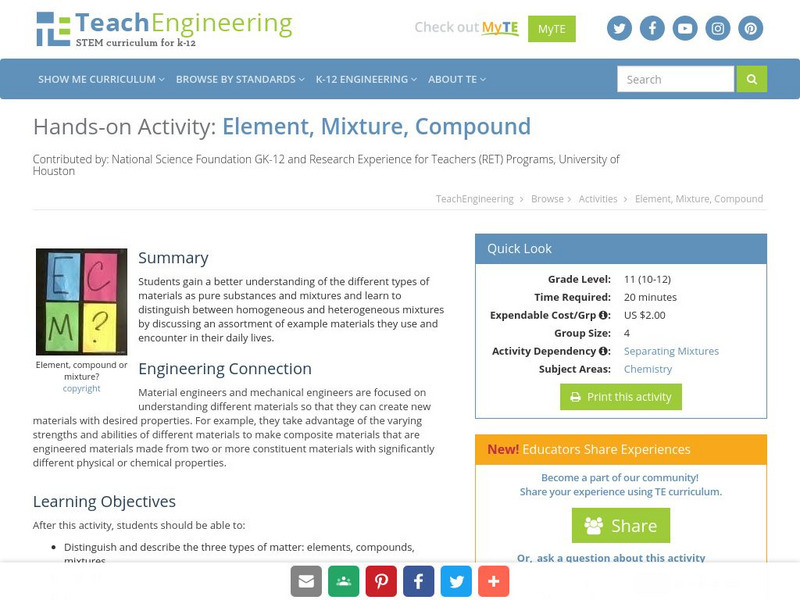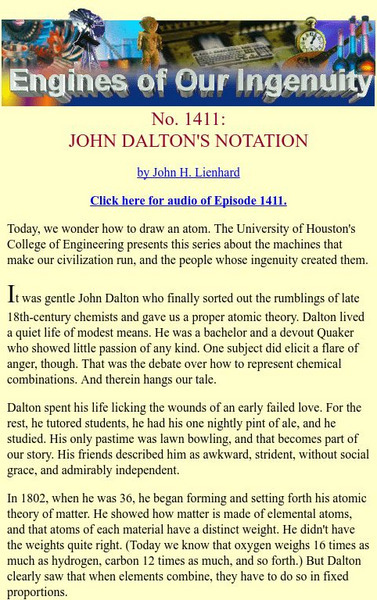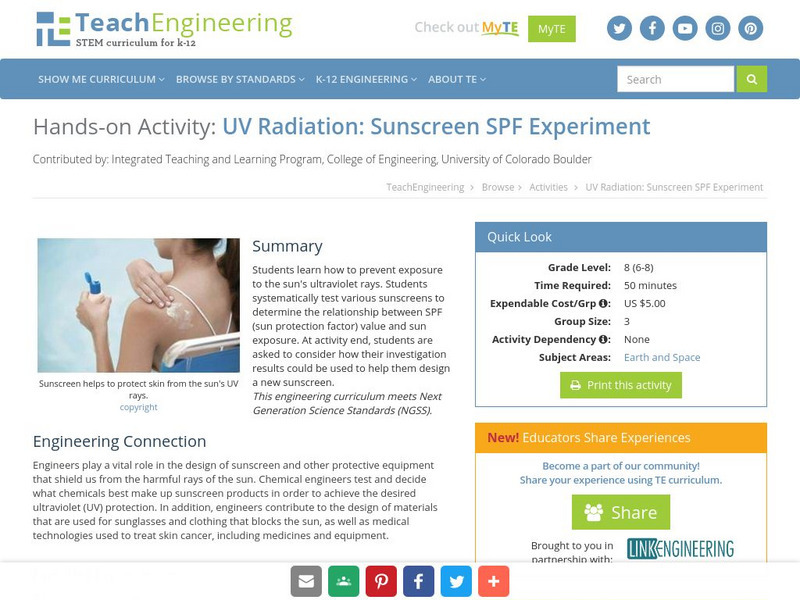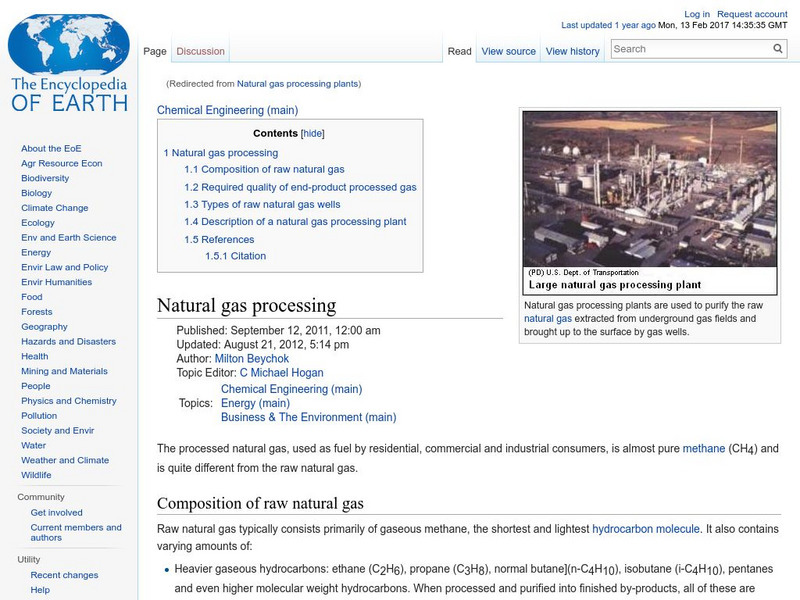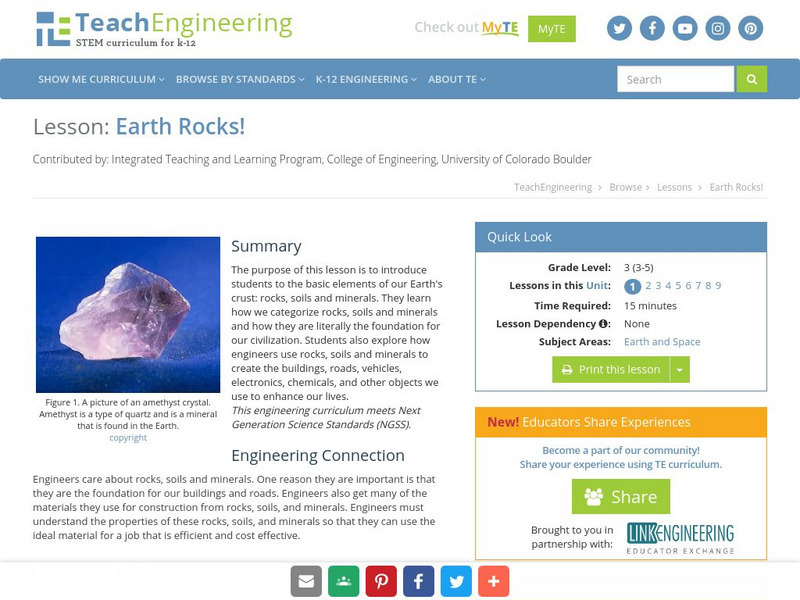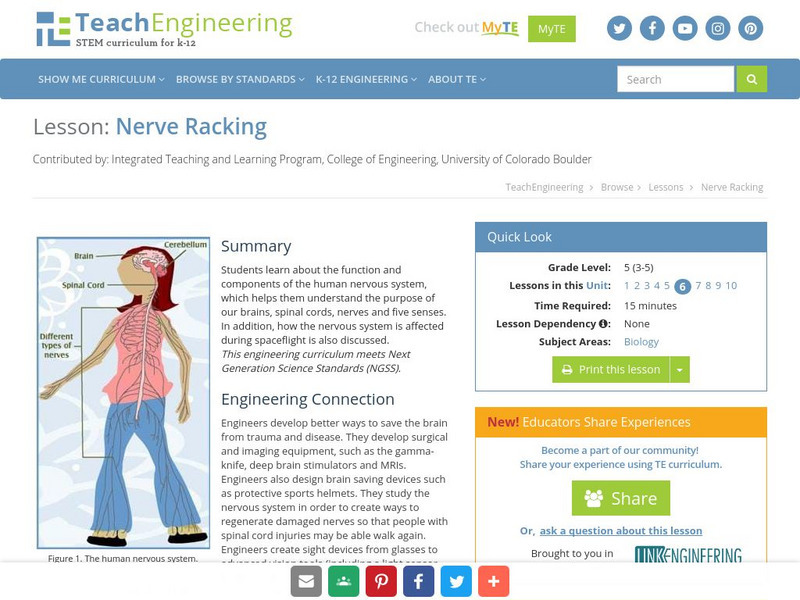TeachEngineering
Teach Engineering: Surface Tension Basics
Students are presented with the question: "Why does a liquid jet break up into droplets?" and introduced to its importance in inkjet printers. A discussion of cohesive forces and surface tension is included, as well as surface acting...
TeachEngineering
Teach Engineering: Wetting and Contact Angle
Students are presented with the concepts of wetting and contact angle. They are also introduced to the distinction between hydrophobic and hydrophilic surfaces. Students observe how different surfaces are used to maintain visibility...
TeachEngineering
Teach Engineering: Common and Natural Logarithms and Solving Equations
Students continue an examination of logarithms in the Research and Revise stage by studying two types of logarithms--common logarithms and natural logarithm. In this study, they take notes about the two special types of logarithms, why...
TeachEngineering
Teach Engineering: Element, Mixture, Compound
This hands-on activity will help the students have a better understanding of different types of materials as pure substances and mixtures and distinguishes the homogeneous and heterogeneous mixtures by discussing some material they use...
Simon Fraser University
Chem1 Virtual Textbook: What Is a Heat Engine and Why Should You Care?
With an overview of topics related to chemical equilibrium, this site provides a foundation to a study of thermodynamics and heat engines. Other topics covered include the fall of heat, nuclear plants, and more.
Massachusetts Institute of Technology
Mit: Open Course Ware: Chemicals in the Environment: Toxicology and Public Health
A college course featuring instructor's notes and case studies about the relationship between exposure to environmental chemicals and human diseases.
University of Houston
University of Houston: Engines of Our Ingenuity: John Dalton's Notation
This is part of a small radio show at the University of Houston. It talks about how John Dalton came up with his version of chemical notation, and how it differs from our version of it today. It is available in audio form also.
Cosmo Learning
Cosmo Learning: Chemical Reaction Engineering
A collection of video lectures from a chemical reaction engineering course taught at the National Programme on Technology Enhanced Learning. In thirty-nine lectures, the course covers topics including chemical reactions, thermodynamics,...
TeachEngineering
Teach Engineering: Cereal Magnets
In this activity, students will design a process that removes the most iron from the cereal. This activity is meant for the students to experiment with different materials using what they know about iron, magnets, and forces to design...
TeachEngineering
Teach Engineering: A Tasty Experiment
Students conduct an experiment to determine whether or not the sense of smell is important to being able to recognize foods by taste. They do this by attempting to identify several different foods that have similar textures. For some of...
TeachEngineering
Teach Engineering: It Burns!
In this activity, students learn how to prevent exposure to the Sun's harmful ultraviolet rays. Students will systematically test various sunscreens to determine the relationship between spf (sun protection factor) value and sun...
TeachEngineering
Teach Engineering: Eat Iron?!!
To gain an understanding of mixtures and the concept of separation of mixtures, students use strong magnets to find the element of iron in iron-fortified breakfast cereal flakes. Through this activity, they see how the iron component of...
TeachEngineering
Teach Engineering: Surface Tension
Surface tension accounts for many of the interesting properties we associate with water. By learning about surface tension and adhesive forces, students learn why liquid jets of water break into droplets rather than staying in a...
Encyclopedia of Earth
Encyclopedia of Earth: Chemical Engineering: Natural Gas Processing
Explains the composition of natural gas and what is required to make it market-ready, types of reservoirs, and what happens in a natural gas processing plant. Includes a diagram showing the whole process. (Published: September 12, 2011)
BiologyWise
Biology Wise: Types of Genetic Engineering
Describes three types of genetic engineering - analytical genetic engineering, applied genetic engineering, and chemical genetic engineering.
Other
Gmfn: u.s. Chemical Giant Monsanto Wields Control
This article has lots of information on the practices of Monsanto, the chemical giant that produces Roundup and Roundup Ready Grains.
TeachEngineering
Teach Engineering: Rock Solid
Rocks cover the earth's surface, including what is below or near human-made structures. With rocks everywhere, breaking rocks can be hazardous and potentially disastrous to people. Learners are introduced to three types of material...
TeachEngineering
Teach Engineering: Earth Rocks!
The purpose of this lesson is to introduce students to the basic elements of our Earth's crust: rocks, soils and minerals. They learn how we categorize rocks, soils and minerals and how they are literally the foundation for our...
TeachEngineering
Teach Engineering: The Earth Is a Changin'
This lesson introduces and describes the main types of erosion (i.e., chemical, water, wind, glacier and temperature). Young scholars learn examples of each type of erosion and discuss how erosion changes the surface of the Earth....
TeachEngineering
Teach Engineering: Aqua Thrusters!
In this activity, students construct their own rocket-powered boat called an "aqua-thruster." These aqua-thrusters will be made from a film canister and will use carbon dioxide gas - produced from a chemical reaction between an antacid...
TeachEngineering
Teach Engineering: Nerve Racking
This lesson describes the function and components of the human nervous system. It helps young scholars understand the purpose of our brain, spinal cord, nerves and the five senses. How the nervous system is affected during spaceflight is...
TeachEngineering
Teach Engineering: Bridging to Polymers: Thermoset Lab
Students act as engineers to learn about the strengths of various epoxy-amine mixtures, and observe the unique characteristics of different mixtures of epoxies and hardeners. Student groups make and optimize thermosets by combining two...
TeachEngineering
Teach Engineering: Spectroscopy
Students learn how using a spectrograph helps us understand the composition of light sources. Using simple materials and holographic diffraction gratings (available online at a variety of sites, including Edmund Scientifics and the...
TeachEngineering
Teach Engineering: Photosynthesis Life's Primary Energy Source
This lesson covers the process of photosynthesis and the related plant cell functions of transpiration and cellular respiration. Students will learn how engineers can use the natural process of photosynthesis as an exemplary model of a...


